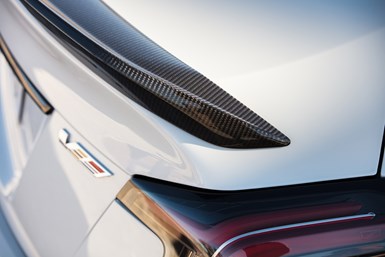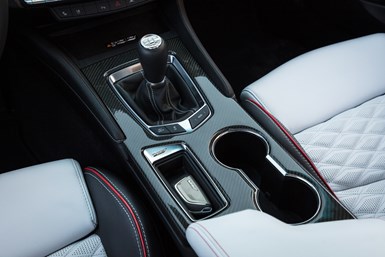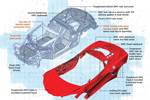
The 2022 CT4-V Blackwing (red) and the CT5-V Blackwing (white): designed and engineered to be track-performers first. And something to take to Costco, too. Photo Credit: General Motors
Brian Smith, exterior design director for Cadillac (Warren, Mich., U.S.), puts it plainly about the brief that he and his colleagues had when developing the exteriors for the 2022 CT4-V Blackwing and the CT5-V Blackwing vehicles: “Every component had to be 100% functional. As well as beautiful.”
Realize that these two sedans are cars that you can conceivably use for your daily drive but which are designed and engineered to be the most track-capable Cadillacs ever to be available at a dealership near you.

Both vehicles are available with composite rear spoilers. Photo Credit: General Motors
As Cadillac Executive Chief Engineer Brandon Vivian says, “V-Series Blackwing stands for the very highest level of execution from Cadillac and offers a distinctly American vision of performance: incredible power and luxurious craftsmanship, with absolutely zero compromise between the two.”
From both a functional-beautiful standpoint, composites play a role in the vehicles, both as a means of reducing mass and as one that helps with their aerodynamic performance. The vehicles initially underwent development with computational fluid dynamics, then models were built — reduced-scale and full-sized — and tested. Full-size vehicles were put in the GM rolling-road wind tunnel to observe the way the air flowed over, around, under and through the vehicles.
What’s interesting to note is that the full-size wind tunnel can bring the vehicles to speeds up to 180 miles per hour (mph). The CT4-V Blackwing, powered by a 3.6-liter, twin-turbo V6 that produces 472 horsepower (hp) and 445 pound-foot (lb-ft) of torque has an estimated top speed of 189 mph; the CT5-V Blackwing, with a 6.2-liter, supercharged V8 that produces 668 hp and 659 lb-ft of torque (making it, incidentally, the most powerful Cadillac ever), has an estimated top speed of more than 200 mph.

In addition to the carbon fiber accents on the center console for the standard six-speed manual TREMEC transmission, it is notable that the medallion cap on the shifter is 3D printed. The vehicles are actually the first GM production vehicles with 3D-printed components: two HVAC ducts and an electrical harness bracket are also printed. Photo Credit: General Motors
All of the vehicles feature an aero package, but there is a specific carbon fiber package that is more extensive for both cars. This includes the front splitter, rear spoiler, rocker extensions and rear valance diffuser. What does that mean? The carbon fiber aero kit provides a 214% lift reduction on the CT4-V Blackwing; it provides a 75% lift reduction on the CT5-V Blackwing.
Related Content
-
Co-molding SMC with braided glass fiber demonstrates truck bed potential
Prepreg co-molding compound by IDI Composites International and A&P Technology enables new geometries and levels of strength and resiliency for automotive, mobility.
-
Recycling hydrogen tanks to produce automotive structural components
Voith Composites and partners develop recycling solutions for hydrogen storage tanks and manufacturing methods to produce automotive parts from the recycled materials.
-
Composites end markets: Automotive (2024)
Recent trends in automotive composites include new materials and developments for battery electric vehicles, hydrogen fuel cell technologies, and recycled and bio-based materials.


.jpg;width=70;height=70;mode=crop)














